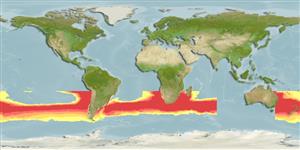Environment: milieu / climate zone / depth range / distribution range
Écologie
marin; profondeur 20 - 250 m (Ref. 54802). Tropical; 19°S - (Ref. 1902)
South Atlantic and Pacific. Western Central Atlantic: Also reported in Nicaragua (Ref. 13613), Uruguay (Ref. 2806), and Peru (Ref. 5530).
Taille / Poids / Âge
Maturity: Lm ? range ? - ? cm
Max length : 28.5 cm TL mâle / non sexé; (Ref. 49326); âge max. reporté: 4 années (Ref. 31631)
Description synthétique
Clés d'identification | Morphologie | Morphométrie
Épines dorsales (Total) : 12; Rayons mous dorsaux (Total) : 23 - 27; Épines anales: 2; Rayons mous anaux: 21 - 24; Vertèbres: 31. Pale to dark blue-grey, back darker than sides; caudal fin dark, other fins clear (Ref. 4412).
Feeds mainly on salps. May be caught using a pelagic trawler (Ref. 33689).
Life cycle and mating behavior
Maturité | Reproduction | Frai | Œufs | Fécondité | Larves
Menni, R.C., R.A. Ringuelet and R.H. Aramburu, 1984. Peces marinos de la Argentina y Uruguay. Editorial Hemisferio Sur S.A. Buenos, Aires, Argentina. 359 p. (Ref. 2806)
Statut dans la liste rouge de l'IUCN (Ref. 130435: Version 2024-1)
Menace pour l'homme
Harmless
Utilisations par l'homme
Pêcheries:
Outils
Articles particuliers
Télécharger en XML
Sources Internet
Estimates based on models
Preferred temperature (Ref.
123201): 11.5 - 23.5, mean 17.7 °C (based on 364 cells).
Phylogenetic diversity index (Ref.
82804): PD
50 = 0.5010 [Uniqueness, from 0.5 = low to 2.0 = high].
Bayesian length-weight: a=0.00955 (0.00639 - 0.01427), b=2.88 (2.77 - 2.99), in cm total length, based on LWR estimates for this species (Ref.
93245).
Niveau trophique (Ref.
69278): 3.6 ±0.0 se; based on diet studies.
Generation time: 1.7 ( na - na) years. Estimated as median ln(3)/K based on 1
growth studies.
Résilience (Ref.
120179): Milieu, temps minimum de doublement de population : 1,4 à 4,4 années (tm=1; tmax=4; K=0.66).
Fishing Vulnerability (Ref.
59153): Low vulnerability (22 of 100).
